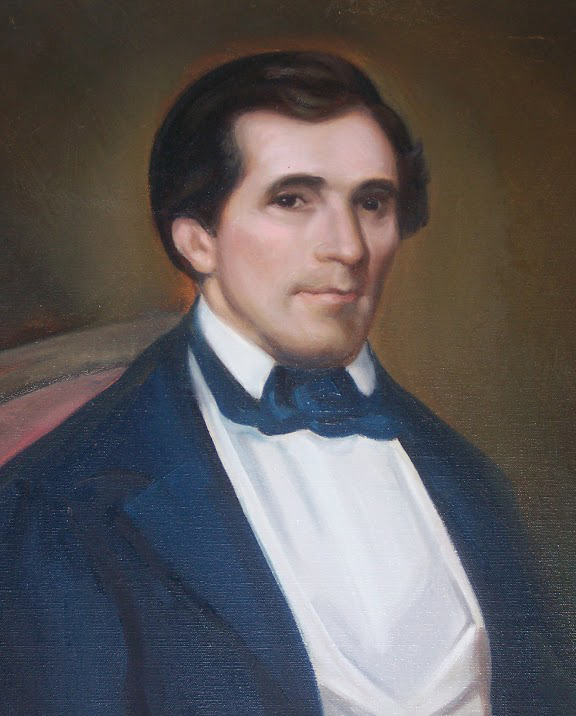Haller Nutt
Haller Nutt owned and operated several plantations including Araby, Evergreen, and Winter Quarters in Louisiana and Cloverdale and Laurel Hill in Mississippi.

Courtesy of Flickr
Haller Nutt Portrait. Malvaney, E.L. (photographer)
Dr. Haller Nutt was a successful cotton planter who owned vast amounts of land stradding the Mississippi River in both Louisiana and Mississippi in the vicinity of Natchez, Mississippi. Nutt’s agricultural research led him to develop a new strain of cotton, the Egypto-Mexican hybrid, that was ideal for cultivation in the Lower Mississippi Valley and led to the region dominating the global cotton market in the nineteenth century. Nutt is also credited with improving the operation of cotton baling by innovating the presses. Nutt’s most visible legacy is Longwood, his opulent but never-completed octagonal, onion-domed mansion in Natchez now open as a house museum. However, one of his more modest properties in Louisiana, Winter Quarters, stands today near the town of Newellton as the only plantation in northeast Louisiana’s Delta parishes spared the torch of advancing Union Army troops during the Civil War.
Nutt was born on February 17, 1816, at Laurel Hill Plantation in Jefferson County, Mississippi, to physician and planter Dr. Rush Nutt, a founder of the Agricultural and Mechanical College at Alcorm, Mississippi, and Eliza Ker. He studied at the University of Virginia from 1832 to 1835 and returned home after college to assist his father in management of the family plantation. Nutt married Julia Augusta Williams in 1840 and the couple had eleven children.
An ambitious agrarian businessman, Nutt owned more than twenty-two estates in his lifetime, which included Winter Quarters, Evergreen, and Araby in Louisiana; and Cloverdale and Laurel Hill in Mississippi. Prior to the Civil War, his fortune was estimated at more than three million dollars. In all he owned forty-three thousand acres and eight hundred slaves.
Nutt bought Winter Quarters in 1850. The plantation was begun in 1805 by his wife’s grandfather, Job Routh, who built a winter hunting lodge on a Spanish land grant located on the Mississippi River flood plain in what would become Tensas Parish. Routh’s heirs added several rooms and a gallery, but Nutt oversaw Winter Quarters’s final phase of construction. The plantation grew to more than two thousand acres and housed more than three hundred slaves.
In the spring of 1860 Nutt began construction on Longwood, his family’s magnificent, six-story, thirty-thousand-square-foot home designed in the Oriental Revival style in Natchez. Nutt enlisted the services of Philadelphia architect Samuel Sloan to design the largest octagonal house in the United States. The exterior work on the byzantine estate was completed by the beginning of the Civil War, but much of the interior work was halted when Sloan’s artisans returned north at the start of the war. Nutt’s death in 1864 left the work unfinished. Of the thirty-two rooms planned for the opulent mansion, only nine rooms on the basement floor were completed by slave labor in 1862. Many tools and construction materials on the upper floors remain left in place to this day where workers abruptly stopped the project in a hasty exodus to flee the South.
Meanwhile, Winter Quarters survived destruction during the Civil War as General Ulysses S. Grant’s troops marched through the region during the Vicksburg Campaign of 1863. Nutt was in Natchez at the time, but the plantation’s overseer obtained letters of protection from two advance officers of the Union Army, General James B. McPherson and General John E. Smith.
Nutt’s years of managing a plantation made him well equipped him to offer advice on all manner of operations. He wrote numerous papers on cotton production and plantation life, including The Book of Receipts, Prescriptions, Useful Rules, etc., For Plantation and Other Purposes. The book includes suggestions such as:
To kill lice on cattle, hogs, and horses: “Wash them with the water in which Irish Potatoes have been boiled.”
To kill cockroaches: “Mix up fly stone (cobalt) with molasses and place it where they are found.”
To cure an egg-sucking dog: “Bate an egg for him with grains tartar emetic and two spoons full of grated Indian Turnip.”
Nutt, a Union sympathizer, suffered substantial financial losses during the Civil War, from cotton destruction, real estate losses, and the expropriation of stores and supplies by both armies. Resulting cash-flow problems ultimately led to foreclosures on the family’s Louisiana plantations. Nutt died from pneumonia on June 15, 1864, and his heirs continued living at Longwood. One of the Nutt’s sons, Sargeant Prentiss Nutt (later Knut), became a lawyer and through connections in Washington, D.C., he lobbied for a bill that would partially compensate the Nutt family for its losses during the war. Irrepressible on the issue, Knut was sometimes at odds with family members over his efforts to seek reparations. The federal government responded with a meager payout totaling no more than $100,000.
Winter Quarters was placed on the National Register of Historic Places in 1978 and is operated today by the Louisiana Office of State Parks. Longwood, which came to be known as “Nutt’s Folly,” survived decades of neglect and near abandonment to become one of Natchez’s most popular tourist attractions. In 1970 it was presented to the Pilgrimage Garden Club, which offers guided tours to the public.
